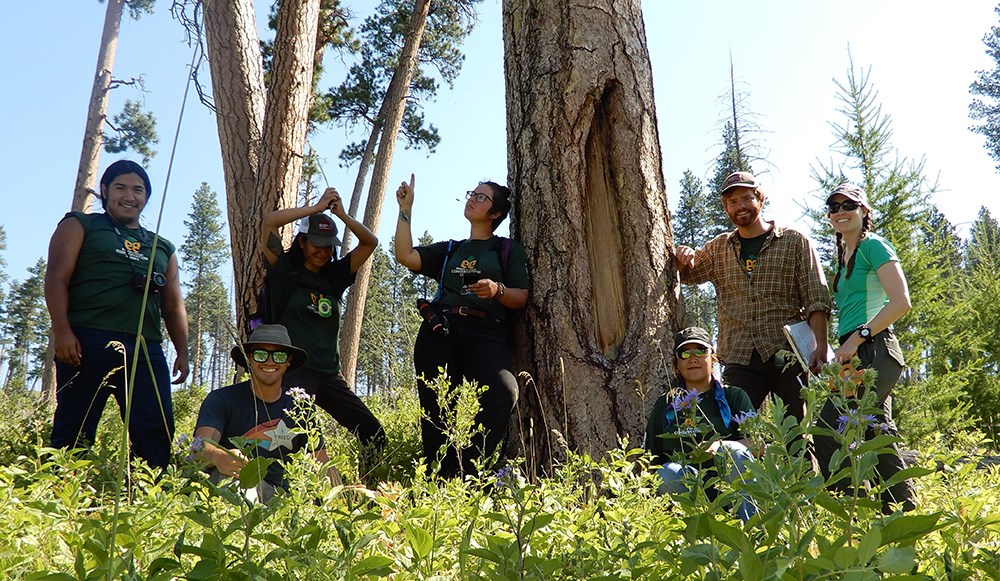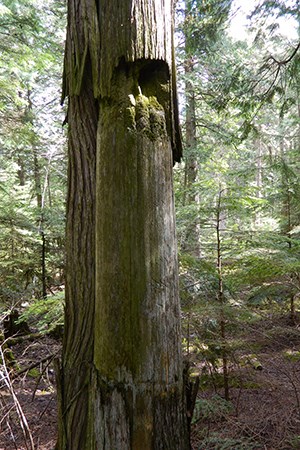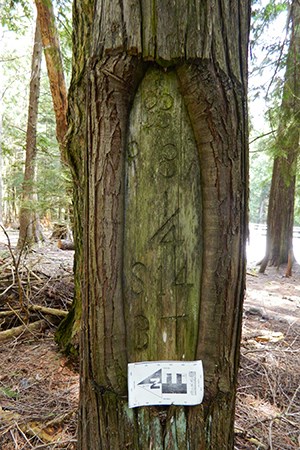
NPS/K. Langley In 2017, Glacier National Park archeologists teamed up with Montana Conservation Corps members from the Blackfeet Youth Corps and the Veterans Corps to survey for and record culturally modified trees in the North Fork. The project involved systematically surveying thousands of acres of off-trail woodland by foot over the course of several weeks. As a result, GNP archeologists and MCC volunteers recorded over twenty new culturally modified trees. 
NPS/K. Langley What are Culturally Modified Trees?A culturally modified tree is any tree that has been cut into and scarred by humans. There are many reasons why people in the past would have modified or scarred trees. For example, Native Americans living in and around Glacier peeled the bark off of ponderosa pines in order to access the inner cambium layer, which could then be harvested as a food source. These bark peelings from the inner layers of ponderosa pine could have been roasted, boiled, or even consumed raw. Another tree species found in Glacier that is associated with the activities of prehistoric peoples is the Western Red Cedar. The bark from cedar trees can be pulled off in strips and put to use in the making of clothing, baskets, and even canoes. The scarring of trees did not end with the arrival of euro-americans and the establishment of Glacier as a National Park. For example, early park rangers would scar trees to use as trail blazes on winter snowshoeing routes, or in the case of a least one Belly River ranger, simply to leave their mark. 
NPS/B. Rowley Are Culturally Modified Trees unique to Glacier National Park?No, the prehistoric modification and scarring of trees occurred all over the wooded areas of Montana and beyond. Today, however, culturally scarred trees are only found in a few places in Montana, such as the Bob Marshall Wilderness and Glacier National Park. The reason for this is the lands within Glacier have been protected by law from logging and development since 1910. As a result, Glacier still retains old growth forests with trees that can be half a millennium old or older! Since the regular scarring of trees in Glacier stopped with the arrival of euro-americans in the latter half of the 1800s, our only evidence of this activity is contained on trees that are at least 150 years old, and ideally much older. 
NPS/K. Langley Why is the recording of these trees important?Part of the job of an archeologist is to monitor, manage, and protect cultural sites throughout the park. By establishing an inventory of culturally modified trees in Glacier, the park is able to implement management actions such as fuel reduction without the risk of destroying a culturally modified tree. Another reason that park archeologists are interested in recording these trees is that unlike other types of archeological sites, they are organic and will not be around forever. By documenting these resources now, future generations of scholars, staff, and visitors will be able to learn about them even after they are gone. Finally, these culturally modified trees tell a story both individually and as a whole about the people who lived in and used these lands before us. When standing before a large old ponderosa with a massive scar, one can imagine early foragers returning to the tree year after year, perhaps making camps right beside them. And when archeologists plot the locations of all the known culturally scarred trees on a map, one can begin to see prehistoric travel corridors and seasonal resource gathering patterns. What's Next?Thousands of acres have been surveyed for culturally modified trees within Glacier National Park, but Glacier is big—over a million acres! The park's cultural resource team discovers new sites and site leads every day, and is already planning for the next big culturally scarred tree survey. What secrets still remain in Glacier's old-growth forests? |
Last updated: September 26, 2017
